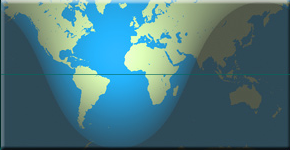 People in many countries throughout the world use satellite images and data. It’s important to be able to determine the exact time a picture was taken or data collected. To meet this need, satellites use a time stamp standard for tagging images and data — Universal Time, referred to as UT; or Zulu Time, designated by the letter Z; or Greenwich Mean Time, abbreviated as GMT. All three designations refer to the same time. The recorded time is the time at the 0º line of longitude, which runs through Greenwich, England.
People in many countries throughout the world use satellite images and data. It’s important to be able to determine the exact time a picture was taken or data collected. To meet this need, satellites use a time stamp standard for tagging images and data — Universal Time, referred to as UT; or Zulu Time, designated by the letter Z; or Greenwich Mean Time, abbreviated as GMT. All three designations refer to the same time. The recorded time is the time at the 0º line of longitude, which runs through Greenwich, England.When a satellite picture is taken or data set collected, it is logged according to traditional military notation for time in the 24-hundred hour notation, based on the time at 0º longitude.
This subject offers the potential for student investigations, mathematics activities and history lessons.
Share with other educators any time-related lesson plans you have used with your students by replying to the UNIVERSAL TIME posting in the Satellite Meteorology forum in NEON.
Link to the NES Virtual Campus home page.
